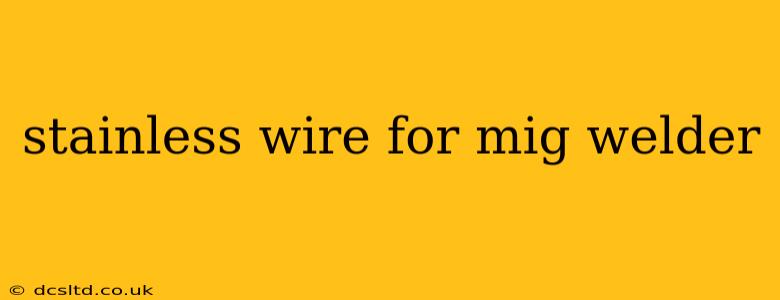MIG welding stainless steel requires specialized wire to achieve strong, corrosion-resistant welds. Choosing the right wire is crucial for a successful project, and this guide will walk you through everything you need to know. We'll cover different wire types, their applications, and considerations for optimal performance.
What are the Different Types of Stainless Steel MIG Welding Wire?
Stainless steel MIG welding wires are categorized primarily by their chemical composition, specifically their chromium (Cr) and nickel (Ni) content. This composition dictates the type of stainless steel being welded and the resulting weld properties. Common types include:
-
308L: This is a very popular choice for its versatility and good corrosion resistance. It's often used for welding 304 and 316 stainless steels. It’s low carbon content (L) minimizes the risk of weld decay.
-
316L: Offers superior corrosion resistance compared to 308L, making it ideal for applications exposed to harsh environments, such as marine or chemical processing. Again, the low carbon content enhances its performance.
-
304L: Similar to 308L but designed specifically for welding 304 stainless steel.
-
Others: Various other stainless steel filler metals exist, each tailored for specific applications and stainless steel grades. Choosing the correct wire for the base metal is paramount for optimal weld quality.
What is the Difference Between Solid and Flux-Cored Stainless Steel Wire?
The choice between solid and flux-cored wire depends on the application and welder's preference. Both offer advantages and disadvantages:
-
Solid Wire: Requires shielding gas (typically Argon or a mixture of Argon and CO2) to protect the weld puddle from atmospheric contamination. This results in a cleaner weld with better corrosion resistance. Solid wire generally produces a higher-quality weld.
-
Flux-Cored Wire: Contains a flux core that provides shielding and deoxidizing agents, reducing the need for external shielding gas. This makes it more portable and suitable for outdoor applications. However, the weld quality might be slightly inferior to solid wire welds, especially regarding corrosion resistance.
How Do I Choose the Right Diameter of Stainless Steel Wire?
Wire diameter impacts weld penetration and speed. Thicker wires deposit more metal per pass, ideal for thicker materials or faster welding. Thinner wires are better for thin materials or intricate welds where precise control is needed. Common diameters range from 0.030" to 0.045", with the optimal diameter chosen based on material thickness and welding parameters.
What Shielding Gas Should I Use with Stainless Steel MIG Welding Wire?
The choice of shielding gas is crucial for stainless steel welding. Argon is preferred for its inert nature and ability to prevent weld contamination. Mixtures of Argon and CO2 can be used, though the CO2 percentage should be carefully controlled to avoid excessive oxidation. The gas composition influences the weld bead appearance and properties. Always consult the wire manufacturer's recommendations for the best gas shielding mixture.
What are Common Problems When MIG Welding Stainless Steel?
Several issues can arise when MIG welding stainless steel, including:
-
Porosity: Caused by contamination from atmospheric gases or improper shielding gas coverage.
-
Crack formation: Often linked to the incorrect wire selection, improper heat input, or poor joint design.
-
Weld discoloration: Can indicate excessive heat input or improper shielding gas protection.
Addressing these issues requires careful attention to wire selection, gas coverage, and proper welding techniques.
Conclusion
Selecting the correct stainless steel MIG welding wire is critical for producing high-quality, corrosion-resistant welds. Understanding the different wire types, their applications, and associated factors such as shielding gas and wire diameter will ensure successful and durable welds. Always consult the manufacturer's instructions and safety guidelines before starting any welding project.
